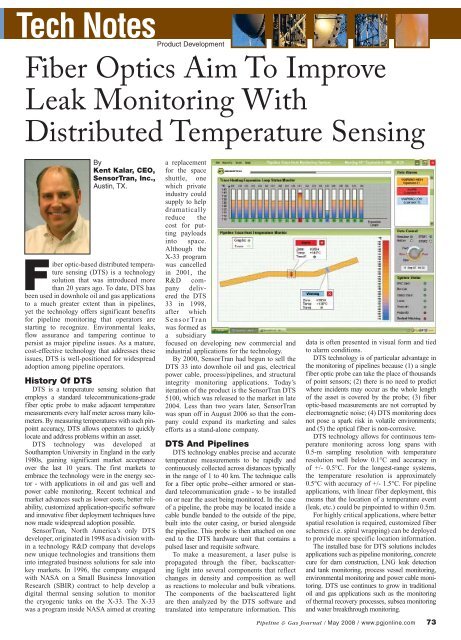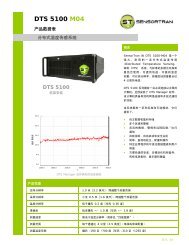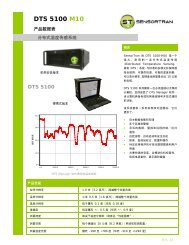Download PDF - SensorTran
Download PDF - SensorTran
Download PDF - SensorTran
You also want an ePaper? Increase the reach of your titles
YUMPU automatically turns print PDFs into web optimized ePapers that Google loves.
Tech NotesProduct<br />
Development<br />
Fiber Optics Aim To Improve<br />
Leak Monitoring With<br />
Distributed Temperature Sensing<br />
By<br />
Kent Kalar, CEO,<br />
<strong>SensorTran</strong>, Inc.,<br />
Austin, TX.<br />
Fiber optic-based distributed temperature<br />
sensing (DTS) is a technology<br />
solution that was introduced more<br />
than 20 years ago. To date, DTS has<br />
been used in downhole oil and gas applications<br />
to a much greater extent than in pipelines,<br />
yet the technology offers significant benefits<br />
for pipeline monitoring that operators are<br />
starting to recognize. Environmental leaks,<br />
flow assurance and tampering continue to<br />
persist as major pipeline issues. As a mature,<br />
cost-effective technology that addresses these<br />
issues, DTS is well-positioned for widespread<br />
adoption among pipeline operators.<br />
History Of DTS<br />
DTS is a temperature sensing solution that<br />
employs a standard telecommunications-grade<br />
fiber optic probe to make adjacent temperature<br />
measurements every half meter across many kilometers.<br />
By measuring temperatures with such pinpoint<br />
accuracy, DTS allows operators to quickly<br />
locate and address problems within an asset.<br />
DTS technology was developed at<br />
Southampton University in England in the early<br />
1980s, gaining significant market acceptance<br />
over the last 10 years. The first markets to<br />
embrace the technology were in the energy sector<br />
- with applications in oil and gas well and<br />
power cable monitoring. Recent technical and<br />
market advances such as lower costs, better reliability,<br />
customized application-specific software<br />
and innovative fiber deployment techniques have<br />
now made widespread adoption possible.<br />
<strong>SensorTran</strong>, North America’s only DTS<br />
developer, originated in 1998 as a division within<br />
a technology R&D company that develops<br />
new unique technologies and transitions them<br />
into integrated business solutions for sale into<br />
key markets. In 1996, the company engaged<br />
with NASA on a Small Business Innovation<br />
Research (SBIR) contract to help develop a<br />
digital thermal sensing solution to monitor<br />
the cryogenic tanks on the X-33. The X-33<br />
was a program inside NASA aimed at creating<br />
a replacement<br />
for the space<br />
shuttle, one<br />
which private<br />
industry could<br />
supply to help<br />
dramatically<br />
reduce the<br />
cost for putting<br />
payloads<br />
into space.<br />
Although the<br />
X-33 program<br />
was cancelled<br />
in 2001, the<br />
R&D company<br />
delivered<br />
the DTS<br />
33 in 1998,<br />
after which<br />
<strong>SensorTran</strong><br />
was formed as<br />
a subsidiary<br />
focused on developing new commercial and<br />
industrial applications for the technology.<br />
By 2000, <strong>SensorTran</strong> had begun to sell the<br />
DTS 33 into downhole oil and gas, electrical<br />
power cable, process/pipelines, and structural<br />
integrity monitoring applications. Today’s<br />
iteration of the product is the <strong>SensorTran</strong> DTS<br />
5100, which was released to the market in late<br />
2004. Less than two years later, <strong>SensorTran</strong><br />
was spun off in August 2006 so that the company<br />
could expand its marketing and sales<br />
efforts as a stand-alone company.<br />
DTS And Pipelines<br />
DTS technology enables precise and accurate<br />
temperature measurements to be rapidly and<br />
continuously collected across distances typically<br />
in the range of 1 to 40 km. The technique calls<br />
for a fiber optic probe--either armored or standard<br />
telecommunication grade - to be installed<br />
on or near the asset being monitored. In the case<br />
of a pipeline, the probe may be located inside a<br />
cable bundle banded to the outside of the pipe,<br />
built into the outer casing, or buried alongside<br />
the pipeline. This probe is then attached on one<br />
end to the DTS hardware unit that contains a<br />
pulsed laser and requisite software.<br />
To make a measurement, a laser pulse is<br />
propagated through the fiber, backscattering<br />
light into several components that reflect<br />
changes in density and composition as well<br />
as reactions to molecular and bulk vibrations.<br />
The components of the backscattered light<br />
are then analyzed by the DTS software and<br />
translated into temperature information. This<br />
data is often presented in visual form and tied<br />
to alarm conditions.<br />
DTS technology is of particular advantage in<br />
the monitoring of pipelines because (1) a single<br />
fiber optic probe can take the place of thousands<br />
of point sensors; (2) there is no need to predict<br />
where incidents may occur as the whole length<br />
of the asset is covered by the probe; (3) fiber<br />
optic-based measurements are not corrupted by<br />
electromagnetic noise; (4) DTS monitoring does<br />
not pose a spark risk in volatile environments;<br />
and (5) the optical fiber is non-corrosive.<br />
DTS technology allows for continuous temperature<br />
monitoring across long spans with<br />
0.5-m sampling resolution with temperature<br />
resolution well below 0.1°C and accuracy in<br />
of +/- 0.5°C. For the longest-range systems,<br />
the temperature resolution is approximately<br />
0.5°C with accuracy of +/- 1.5°C. For pipeline<br />
applications, with linear fiber deployment, this<br />
means that the location of a temperature event<br />
(leak, etc.) could be pinpointed to within 0.5m.<br />
For highly critical applications, where better<br />
spatial resolution is required, customized fiber<br />
schemes (i.e. spiral wrapping) can be deployed<br />
to provide more specific location information.<br />
The installed base for DTS solutions includes<br />
applications such as pipeline monitoring, concrete<br />
cure for dam construction, LNG leak detection<br />
and tank monitoring, process vessel monitoring,<br />
environmental monitoring and power cable monitoring.<br />
DTS use continues to grow in traditional<br />
oil and gas applications such as the monitoring<br />
of thermal recovery processes, subsea monitoring<br />
and water breakthrough monitoring.<br />
Pipeline & Gas Journal / May 2008 / www.pgjonline.com 73
Tech NotesProduct<br />
Development<br />
DTS Today<br />
While DTS has been used traditionally for oil<br />
well monitoring, the recent development of longrange<br />
capabilities has led to an increased acceptance<br />
in applications related to pipelines and power cables.<br />
In the past, the DTS industry was viewed<br />
as a niche market understood only by a small<br />
group of “white glove” scientists and highly<br />
skilled technicians. Specifically, the DTS<br />
industry had been unable to grow rapidly due<br />
to the product’s complexity, especially during<br />
deployment and calibration of the systems.<br />
Moving DTS setup, calibration, operation,<br />
and ongoing analysis out of the hands of those<br />
same “white gloves”, and into the “leather<br />
gloves” in field crews is a critical shift that is<br />
now making DTS technology more accessible<br />
to all of these industries. Over the last year,<br />
the components were introduced to create an<br />
active plug and play solution for DTS, which<br />
features the following capabilities:<br />
The ability for field engineers to install<br />
and calibrate the DTS on site without needing<br />
an expert — the system calibrates itself; The<br />
ability of the system to react to and adjust for<br />
fiber attenuation caused by a shifting pipeline;<br />
andAuto-correcting and continuous verification,<br />
allowing the system to operate with little/<br />
no operator involvement.<br />
New Standards Organization<br />
While DTS operation is increasingly simplified,<br />
understanding the intricacies of the<br />
specification process and performance parameters<br />
can be confusing to newcomers. Several<br />
first-of-their-kind industry initiatives, including<br />
the creation of a standards organization<br />
are under way. For example, <strong>SensorTran</strong> and<br />
J-Power Systems (a subsidiary of Sumitomo<br />
Corp.) have joined together to create the<br />
International Distributed Optical Performance<br />
Testing Standards Association (IDOPTS). The<br />
goal of IDOPTS is to help buyers and users<br />
understand what the key specifications are,<br />
how they compare across manufacturers, and<br />
how the specifications are formulated to create<br />
standard testing procedures.<br />
Future Of DTS<br />
As DTS technology becomes a standard component<br />
for large asset monitoring applications —<br />
pipeline monitoring, oil and gas thermal recovery<br />
and implementation of the Smart Grid — manufacturers<br />
are continuing to add functionality and<br />
capabilities that ease installation and provide<br />
more value. Within the next year, advances in<br />
distributed fiber optic monitoring technology<br />
will enable the measurement of strain, corrosion<br />
and temperature using a single fiber probe.<br />
Being able to monitor multiple conditions with<br />
a single cable installation and a single interrogation<br />
unit will drive up ROI and promote efficient,<br />
consolidated data collection.<br />
Also on the near-term horizon are networked,<br />
lower-power, small footprint versions of DTS<br />
systems, which are specifically designed for<br />
pipelines and similar applications where groups<br />
of units are to be deployed outside in remote<br />
areas. These DTS systems are solar powered —<br />
allowing for outdoor mounting — can be run<br />
remotely and are autonomous. This means no<br />
operator intervention is required to collect, analyze<br />
and transmit decision-support information.<br />
To achieve widespread adoption, providers must<br />
continue to push the DTS technology envelope.<br />
Bringing scientific breakthroughs into the marketplace<br />
at a rapid pace will fuel sustained growth<br />
within the industry. P&GJ<br />
Author: Kent Kalar is CEO and president of<br />
<strong>SensorTran</strong>. He joined the company in 2004.<br />
From 1998-2003 he served as president and<br />
CEO of Extreme Devices, Inc., a semi-conductor<br />
fabrication company that produced widebandgap<br />
devices. Before Extreme Devices, he<br />
was vice president-business development at<br />
SPEC where he was responsible for strategic<br />
planning, generating value from existing intellectual<br />
property, and commercializing SPEC’s<br />
technologies and products. He earned an MBA<br />
from the Carlson School of Business at the<br />
University of Minnesota and a B.S degree in<br />
electrical engineering from Kettering University<br />
(formerly General Motors Institute)<br />
74 Pipeline & Gas Journal / May 2008 / www.pgjonline.com





